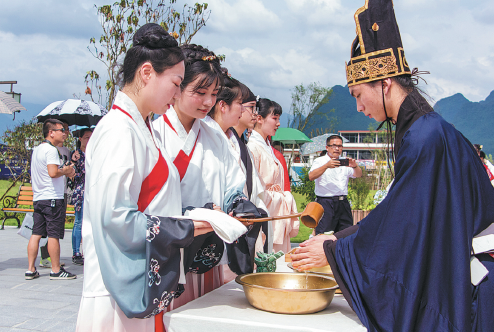Green gems shine
Guilin's karst terrain, part of Guangxi's world heritage site listing, has inspired traditional Chinese landscape painters for centuries with the Lijiang River complementing the breathtaking mountain sights.
The local authorities have been banking on the protection and promotion of the river and its environs in recent years amid increasing development. Recognizing the river's source reliance on rainwater and plugging seasonal low water level risks, Guilin city has invested more than 6 billion yuan ($915.6 million) to boost ecological water replenishment projects in Lijiang's upper reaches. They aim to better regulate the drainage basin, maintain the natural surroundings and improve river navigation.

Tourists experience a traditional hand-washing ceremony at Sanqianli, Guangxi Zhuang autonomous region, in June 2019. CHINA DAILY
Wang Zixi, head of the Guilin tourism bureau, says the city is moving beyond the difficulties posed by the COVID-19 pandemic and is tapping demand from home and abroad with competitive and sustainable products and services.
"We're already recording impressive domestic recovery in the cultural tourism sector. Guilin will continue to leverage its physical and cultural advantages to develop tourism management and facilities," Wang says.
Natural comforts
Guilin is gearing up its offerings as a global tourist destination built on natural beauty, Chinese aesthetics and ethnic charm.
The Sanqianli Leisure Tourism Resort is one of the latest efforts to develop and upgrade green tourism. The resort in Xingping, which is under Yangshuo county, covers more than 100 hectares with an investment of more than 3 billion yuan. It boasts an awe-inspiring karst range as a backdrop to a tributary of the Lijiang River.
Visitors can experience ethnic snacks and performances across a network of culturally themed streets, which is host to an art museum dedicated to master ink painter Xu Beihong. The modern art pioneer spent time in Guilin and was inspired by its beauty.














